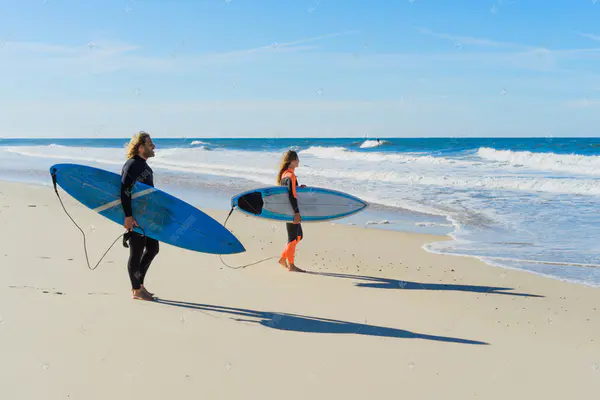Surfing, a sport deeply intertwined with the natural rhythms of the ocean, involves a myriad of specialized equipment to match varying wave conditions. Central to a surfer’s toolkit is the concept of a “quiver,” a term that encompasses the diverse array of surfboards tailored for different wave types, sizes, and styles of riding. Understanding the role and composition of a quiver is essential for surfers aiming to optimize their performance across a range of surfing conditions.
Introduction to Surfing and Equipment
Surfing, originating from ancient Polynesian cultures and evolving into a global sport, revolves around riding waves using surfboards. The sport’s popularity has surged worldwide, with surfers chasing the perfect wave in diverse coastal environments. Mastery of surfing requires not only skill and athleticism but also an understanding of how equipment influences performance. Central to this understanding is the concept of the surfing quiver—a collection of surfboards tailored to exploit various wave conditions.
The Evolution of Surfboard Designs
Surfboards have evolved significantly over time, driven by technological advancements, material innovations, and a deepening understanding of hydrodynamics. From traditional wooden boards to modern fiberglass and epoxy constructions, each design iteration has aimed to enhance maneuverability, speed, and stability on the wave face. The evolution of surfboard shapes—from longboards to shortboards, fish designs to gun models—reflects the sport’s diverse approaches to wave riding.
Components of a Surfing Quiver
A surfing quiver typically consists of several surfboards, each optimized for specific wave characteristics. Essential components include:
- Longboards: Known for stability and ease of paddling, longboards excel in small, rolling waves, making them ideal for beginners and traditionalists alike.
- Shortboards: Characterized by their maneuverability and responsiveness, shortboards are designed for quick turns and aerial maneuvers in steep, powerful waves.
- Fish Boards: Featuring a wider template and twin-fin setup, fish boards offer speed and agility in smaller, mushier waves, popularized during the retro surf revival of the 1970s.
- Gun Boards: Designed for riding large, fast-moving waves, gun boards prioritize speed, control, and paddle power to handle critical drops and challenging conditions.
- Funboards and Hybrid Designs: Bridging the gap between longboards and shortboards, funboards offer versatility for surfers transitioning between different wave types.
See Also: What Is a Kook in Surfing Terms
Choosing the Right Surfboard for Specific Conditions
Optimizing performance in varying wave conditions requires careful selection from one’s quiver:
- Wave Size and Shape: Smaller waves may necessitate a longboard or fish board for enhanced paddling and speed, whereas larger waves demand the stability and control of a gun board.
- Wave Power and Speed: Steeper, more powerful waves benefit from the agility and responsiveness of shortboards, facilitating quick turns and aerial maneuvers.
- Surfer Skill Level: Beginners often start with longer, more stable boards before transitioning to shorter, more maneuverable designs as their skills progress.
Maintaining and Upgrading Your Quiver
Proper care and maintenance are crucial for extending the lifespan of surfboards within a quiver:
- Storage: Storing boards in a cool, dry place away from direct sunlight prevents delamination and maintains structural integrity.
- Repair and Restoration: Prompt repairs of dings and cracks prevent water damage and ensure optimal performance.
- Board Upgrades: Regularly updating one’s quiver with new designs and materials can enhance surfing capabilities and adaptability to evolving wave conditions.
Conclusion
A comprehensive surfing quiver represents more than just a collection of boards—it embodies a surfer’s readiness to tackle a diverse range of wave conditions with confidence and proficiency. By understanding the nuances of board design, wave dynamics, and personal skill level, surfers can assemble a quiver that optimizes their performance and enjoyment in the water. As surfing continues to evolve, so too will the quivers of dedicated surfers worldwide, adapting to new technologies and pushing the boundaries of what is possible in wave riding.
FAQ: What Is a Quiver in Surfing
Q: What Is a Turtle Roll in Surfing?
A: A turtle roll is a surfing move where the surfer rolls over the front of the board, from lying on their stomach to lying on their back, while keeping their feet on the board. This move helps the surfer maintain control and balance while riding a wave.
Q: How Do You Perform a Turtle Roll?
A: To perform a turtle roll, the surfer needs to be comfortable lying on their stomach and have good balance on the board. The move starts with the surfer shifting their weight forward and using their arms to push themselves up and over the front of the board. As they roll, they need to keep their feet on the board and land on their back with their legs still in position.
Q: Is a Turtle Roll Difficult to Learn?
A: For beginners, a turtle roll can be challenging to learn as it requires good balance, flexibility, and coordination. However, with practice and guidance from an experienced surfer or instructor, most people can learn to perform a turtle roll.
Q: What Are the Benefits of Learning a Turtle Roll?
A: Learning a turtle roll can help improve a surfer’s balance, stability, and control on the board. It also allows the surfer to change their position quickly and easily, which can be useful when maneuvering through different parts of a wave.
Q: Are There Any Risks Associated With Performing a Turtle Roll?
A: Like any surfing move, there are risks associated with performing a turtle roll. The main risk is losing control and falling off the board, which can lead to injury. It’s important for surfers to practice this move in safe conditions and under the supervision of an experienced instructor.

